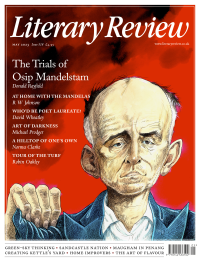Iain Bamforth
Getting High, Tripping Out
Psychonauts: Drugs and the Making of the Modern Mind
By Mike Jay
Yale University Press 376pp £20
In his latest book, Psychonauts, Mike Jay returns to the group of gentlemen researchers at the Pneumatic Institution in Bristol who featured in his 2009 work The Atmosphere of Heaven, the better to explore the intricate history of how new substances with unsuspected mind-altering effects became part of the general cultural and social landscape in the 19th century, only to suffer a dramatic fall from grace at the beginning of the 20th. His subject is, in a word, drugs – a loose term that most likely has its origins in a Dutch term for dried goods. Drugs span the entire gamut of chemical substances, from the pharmaceutical to the psychoactive to the recreational, and Jay shows how in the ‘drug-averse twentieth century’ considerable efforts were made – not least on the back of lobbying by the American Pharmaceutical Association in what is known as the Progressive Era and though the 1961 UN Single Convention on Narcotic Drugs – to adopt a more specific terminology and stigmatise ‘drugs’ as illicit and harmful.
Within a month of the Pneumatic Institution’s establishment in 1799 by the pioneering physician Thomas Beddoes to develop new gases for the treatment of lung diseases, his assistant Humphry Davy had succeeded in producing nitrous oxide, a ‘species of air’, the effects of inhaling which were a sense of energy and exuberance. Davy discovered that taking in nitrous oxide ‘could create a state of consciousness in which the mind appeared to exist independently of the material world’. Visionary states were now summonable by anyone with chemical apparatus and a gas bladder. The curious pleasure of inhaling the intoxicating gas allowed persons to unshackle their normal selves and indulge in episodes of ‘antic’ behaviour of which they had no recollection in retrospect. Although Davy anticipated that nitrous oxide might have an application in surgical operations, it took half a century – for practical and conceptual reasons – for this idea to be developed. (William James documented its salvational effects in the epiphanies described in 1902 in his The Varieties of Religious Experience.)
The early 19th century, as Jay notes, was ‘a golden age of drug discovery’, particularly in Germany. Various plant extracts were isolated and crystallised: morphine and codeine joined caffeine and nicotine (less potent alkaloids but stimulants nonetheless) on the pharmacy shelf. The experimenter used his own body as

Sign Up to our newsletter
Receive free articles, highlights from the archive, news, details of prizes, and much more.@Lit_Review
Follow Literary Review on Twitter
Twitter Feed
'A charming and amusing personal history'
Don't miss this brilliant @Lit_Review review of #WorldCupFever 👇
@KuperSimon's must-read footballing journey in nine tournaments is out now ⚽️🏆
Michael Taylor - The Beautiful Game
Michael Taylor: The Beautiful Game - World Cup Fever: A Footballing Journey in Nine Tournaments by Simon Kuper; Th...
literaryreview.co.uk
In the summer of 1918, the Caspian port of Baku played host to a remarkable group of Allied soldiers, sent to defend oil wells against the Ottomans.
Anna Reid recounts their escapades.
Anna Reid - Mission Impossible
Anna Reid: Mission Impossible - Mavericks: Empire, Oil, Revolution and the Forgotten Battle of World War One by Nick Higham
literaryreview.co.uk
Alfred, Lord Tennyson is practically a byword for old-fashioned Victorian grandeur, rarely pictured without a cravat and a serious beard.
Seamus Perry tries to picture him as a younger man.
Seamus Perry - Before the Beard
Seamus Perry: Before the Beard - The Boundless Deep: Young Tennyson, Science, and the Crisis of Belief by Richard Holmes
literaryreview.co.uk